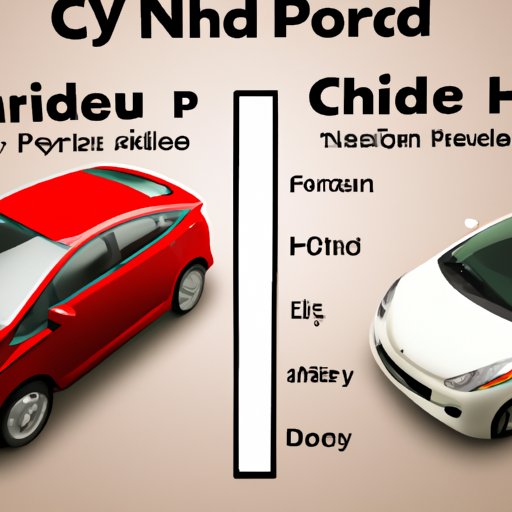Introduction
Hybrid cars are becoming increasingly popular as the need for eco-friendly transportation rises. But what exactly is a hybrid car, and how does it work? In this article, we will explore the basics of hybrid car technology, along with a step-by-step guide to understanding how a hybrid car works. We will also investigate the pros and cons of driving a hybrid vehicle.
Explaining the Basics of Hybrid Car Technology
A hybrid car is a vehicle that combines traditional gasoline engine technology with electric motor technology. Unlike a conventional car, which uses only an internal combustion engine (ICE) to power its wheels, a hybrid car utilizes both an ICE and an electric motor to generate power. This combination of technologies allows the car to be more fuel efficient, reduce emissions, and provide greater overall performance.
There are several different types of hybrid cars available on the market today, including parallel hybrids, series hybrids, and plug-in hybrids. Parallel hybrids combine the use of an ICE and an electric motor to generate power, while series hybrids rely solely on the electric motor for power. Plug-in hybrids are similar to series hybrids but can be recharged using a standard electrical outlet.
When comparing hybrid and conventional cars, there are some key differences to consider. Hybrid cars typically have better fuel economy than conventional cars due to their ability to switch between electric and gasoline power sources. They are also more environmentally friendly, as they produce fewer emissions than conventional cars. However, hybrid cars tend to cost more than conventional cars upfront, and their batteries may need replacing more frequently.

An Overview of How a Hybrid Car Works
Now that you understand the basics of hybrid car technology, let’s take a look at how a hybrid car actually works. The following is a step-by-step guide to understanding a hybrid car:
- The car starts out in electric mode, powered by the car’s battery. The battery supplies electricity to the electric motor, which then powers the wheels.
- As the car accelerates, the gasoline engine kicks in and begins to supplement the electric motor’s power. This helps the car accelerate faster and improves overall performance.
- At certain speeds, the gasoline engine will shut off and the car will transition back to electric mode. This helps conserve fuel and reduces emissions.
- When the car needs more power, such as when climbing hills or passing other cars, the gasoline engine will kick in again and provide additional power.
- Finally, the car will transition back to electric mode once the desired speed is reached.
In order to understand how a hybrid car works, it is important to examine the different components of the vehicle. The main components of a hybrid car are an internal combustion engine (ICE), an electric motor, a battery pack, a transmission, and a generator. The ICE is responsible for providing the power to the wheels, while the electric motor provides additional power when needed. The battery pack stores energy generated by the ICE, while the transmission helps transfer power from the ICE to the wheels. Finally, the generator is responsible for converting the energy stored in the battery pack into electricity to power the electric motor.

Investigating the Pros and Cons of Driving a Hybrid Vehicle
Driving a hybrid car has its advantages and disadvantages. On the plus side, hybrid cars are generally more fuel-efficient than conventional cars, meaning you can save money on gas. Additionally, hybrid cars produce fewer emissions than conventional cars, which can help reduce your environmental impact. Finally, hybrid cars often come with advanced features, such as regenerative braking, which can help improve your overall driving experience.
On the downside, hybrid cars tend to be more expensive than conventional cars. Additionally, their batteries may need to be replaced more frequently than those of conventional cars. Finally, some hybrid cars may not perform as well as their conventional counterparts in certain situations, such as off-roading.
Conclusion
In conclusion, hybrid cars are becoming increasingly popular due to their fuel efficiency and environmental friendliness. By understanding the basics of hybrid car technology and how a hybrid car works, you can make an informed decision when considering purchasing a hybrid vehicle. From the step-by-step guide to understanding a hybrid car to the pros and cons of driving one, this article has provided an in-depth look into this increasingly popular form of transportation.
Overall, hybrid cars offer several benefits, from improved fuel economy to reduced emissions. However, they can also be more expensive and require more frequent battery replacements than conventional cars. Ultimately, the decision to purchase a hybrid car is a personal one, and should be based on your individual needs and preferences.
(Note: Is this article not meeting your expectations? Do you have knowledge or insights to share? Unlock new opportunities and expand your reach by joining our authors team. Click Registration to join us and share your expertise with our readers.)
